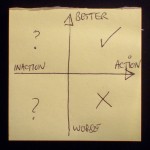 I find that I have to draw pictures when I am thinking – it seems to help.
I find that I have to draw pictures when I am thinking – it seems to help.
One thing I have been thinking about this week is how to predict the outcome of an action; because I don’t want to do something that has a negative outcome that I did not anticipate.
I know that whatever I do will change the “system” and may have an ongoing effect that may be positive and negative; and once I have set the ball rolling even reversing my action may not change the course.
So the problem I have is this: although I can work out what I feel is the best thing to do now, I do not seem to be able to predict the knock-on effects of my actions. I know from experience that I may be the recipient of the future effect of my actions today. I will get feedback one way or the other.
So how do we work out what is the best thing to do now? How do we get good feedback?

